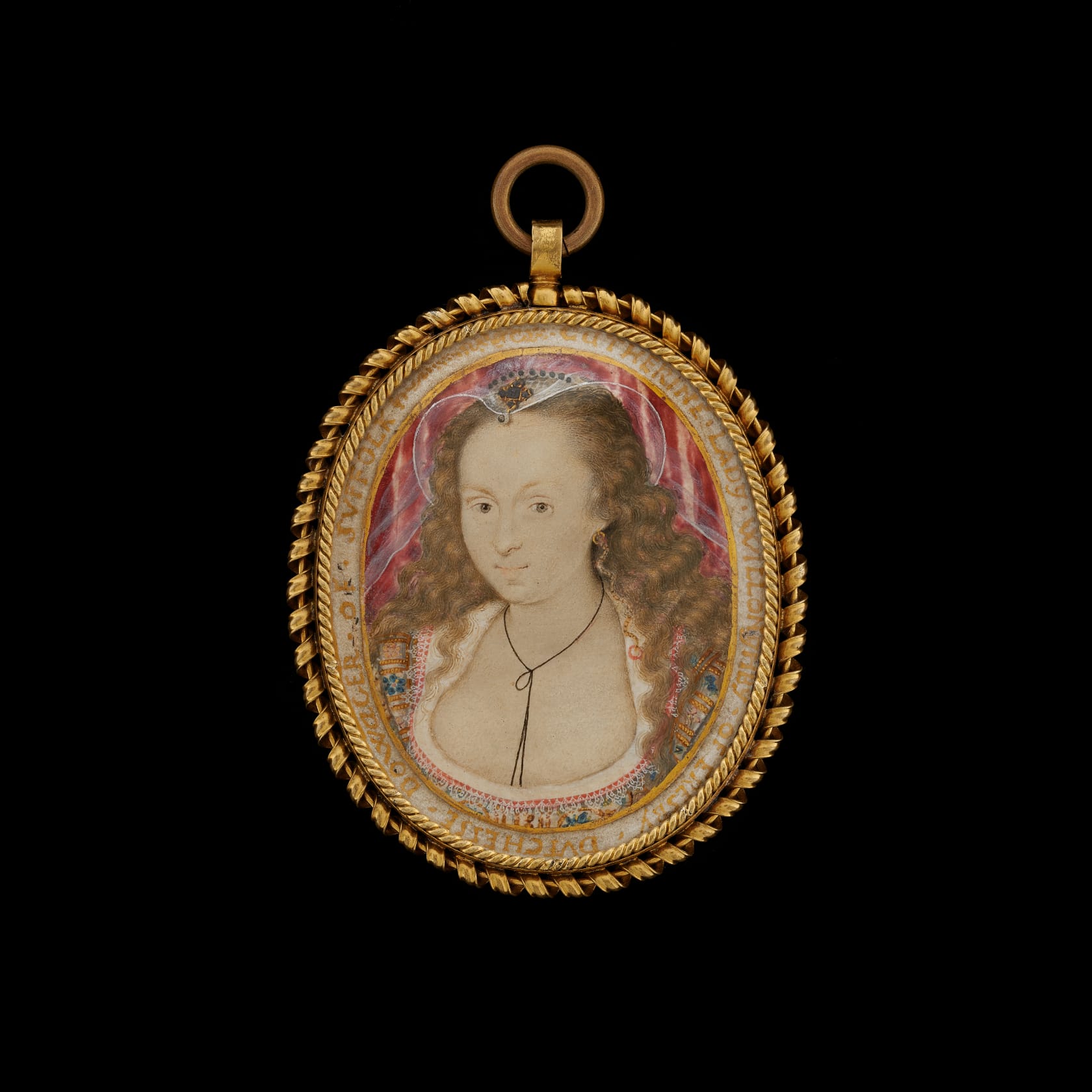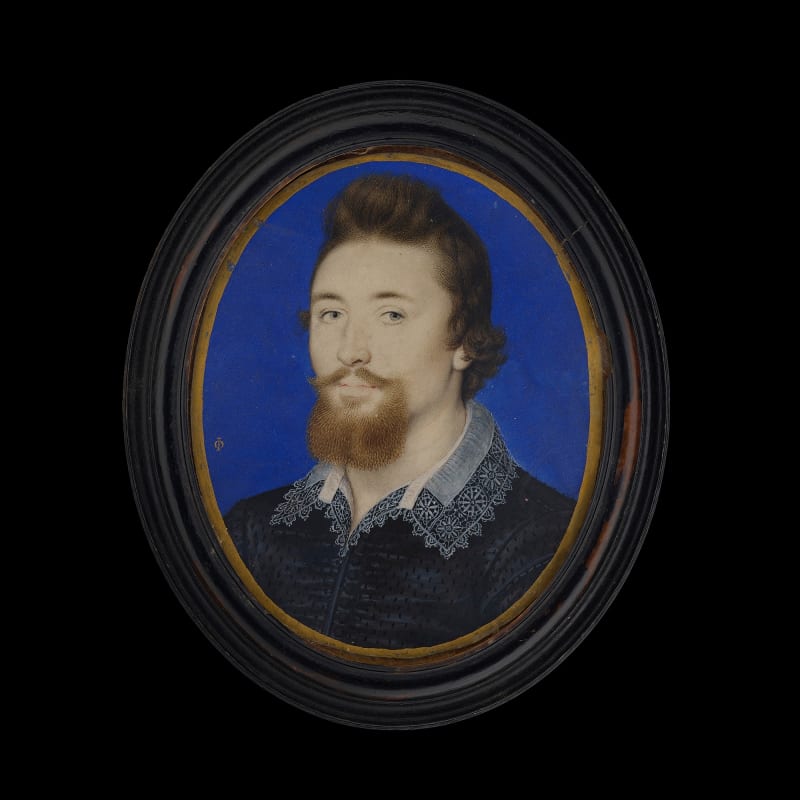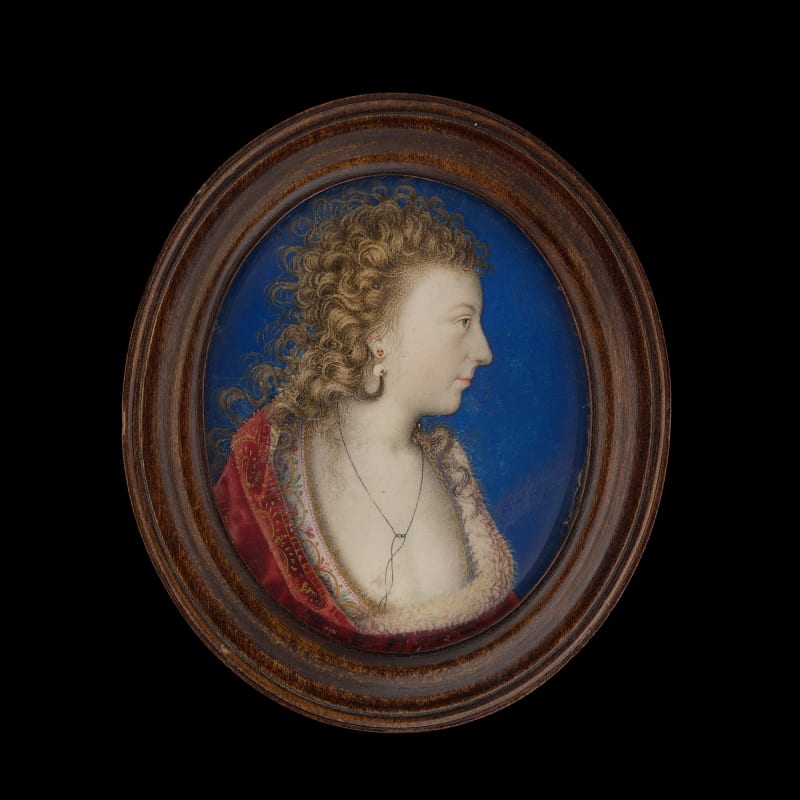To view all current artworks for sale visit philipmould.com
Painted circa 1610 by the court artist Isaac Oliver, the present portrait portrays a female sitter of high status, wearing masque costume. The identification of the sitter as ‘Catherine, Baroness Willoughby D’Eresby, Duchess Dowager of Suffolk’ (1519-1580), her name recorded in gold paint on an additional, later border around the miniature, cannot be sustained as her date of death precedes the execution of this miniature by some thirty years.
Isaac Oliver’s female sitters often choose to be portrayed wearing masque costume. Masques were vehicles for conspicuous expenditure by the host and were usually a combination of music, dance and mime. Performed not by actors but often by courtiers, staged at the grand houses of the aristocracy or at court, they were the only opportunity for women to perform on stage (albeit silently). Like the elaborate staging and scenery, masque costumes were often specifically designed for the occasion, together...
To view all current artworks for sale visit philipmould.com
Painted circa 1610 by the court artist Isaac Oliver, the present portrait portrays a female sitter of high status, wearing masque costume. The identification of the sitter as ‘Catherine, Baroness Willoughby D’Eresby, Duchess Dowager of Suffolk’ (1519-1580), her name recorded in gold paint on an additional, later border around the miniature, cannot be sustained as her date of death precedes the execution of this miniature by some thirty years.
Isaac Oliver’s female sitters often choose to be portrayed wearing masque costume. Masques were vehicles for conspicuous expenditure by the host and were usually a combination of music, dance and mime. Performed not by actors but often by courtiers, staged at the grand houses of the aristocracy or at court, they were the only opportunity for women to perform on stage (albeit silently). Like the elaborate staging and scenery, masque costumes were often specifically designed for the occasion, together with expensive jewels and accessories. No flight of fancy was too fantastical, no staged illusion too technically challenging when it came to courtly masques. Writer Ben Jonson described the costumes for his 1606 masque, Hymenaei (designed by Inigo Jones with whom he worked in partnership from 1605 until 1640) thus:
“The ladies’ attire was wholly new, for the invention, and full of glory, as having in it the most true impression of a celestial figure: the upper part of white cloth of silver wrought with Juno’s birds and fruits; a loose under garment, full gathered, of carnation, striped with silver and parted with a golden zone; beneath that another flowing garment of watchet cloth of silver, laced with gold… The attire of their heads did answer, if not exceed; their hair being carelessly…bound under the circle of a rare and rich coronet adorned with all variety and choice of jewels, from the top of which flowed a transparent veil down to the ground, whose verge, returning up, was fastened to either side in most sprightly manner. Their shoes were of azure and gold set with rubies and diamonds…”[1]
The above description could easily be applied to the present portrait. The loose hair of the sitter, together with her low-cut gown, would have been seen in court circles as a particularly risqué combination outside the validation of the masque performance. Susan North describes how masques were not confined to the court but also took place in the more informal setting of the country house; ‘Here ‘masque costume’ was contrived of garments already in a lady’s wardrobe – an embroidered waistcoat and decorative petticoat’.[2]Although the masques which took place at the court of Queen Anne, wife of James I and VI, had costumes specifically designed by Inigo Jones, the less formal and courtly masques showcased outfits adapted from the sitter’s existing clothes, with daring low cut bodices combined with veils and jewelled hair ornaments.[3]The sitter in this portrait wears an unusual black and white accessory, possibly in the form of a serpent and enamelled in gold. This may relate specifically to a performance of William Shakespeare’s play Anthony and Cleopatra, which had recently been staged at court.[4]
It is possible to speculate why the sitter in the present miniature would wish to be portrayed in masque costume. Performed only once, masques were often held to celebrate momentous occasions, for example The Lord’s Masque, written by Thomas Campion (1567-1620) was performed in 1612 celebrate the marriage of James I’s daughter Elizabeth to Frederick the Elector Palatine. The sitter in the present miniature may have been painted in masque costume at an event to mark an occasion, the miniature providing a visual memory. It is also conceivable that the secret and often romantic intent of portrait miniatures allowed for a more seductive image to be commissioned between lovers, the masque costume providing a perfect vehicle for an image of a more provocative nature. Here, the sitter’s scoop-necked gown is cut so low as to reveal most of her chest, from the black silk cord between her breasts may have been suspended a reciprocal miniature. The ring tied to the end of the serpent-jewel may have been a gold ring representative of betrothal or marriage.
French-born Isaac Oliver had trained under the well-honed eye of Nicholas Hilliard (c.1547-1619), the most talented of his apprentices and the only one to pose as a serious rival to his master. He set up as an independent artist by the end of the 1580s and was introduced to the court by Robert Devereux, 2ndEarl of Essex and a favourite of Elizabeth I. When Elizabeth died in 1603, Hilliard continued as court painter to James I, but his Queen Consort, Anne of Denmark, turned to Oliver as her official limner. By the time the present work was commissioned, Oliver would have been a well-known figure at the court of Queen Anne and her son Henry, Prince of Wales. In addition, Oliver worked alongside Inigo Jones, the influential designer who was responsible for so much of the fabric of the Jacobean court, including the designs for the queen’s extravagant masques.
[1]Quoted in Strong, R. (1983) Artists of the Tudor Court: the Portrait Miniature Rediscovered 1520-1620, London: Victoria and Albert Museum, p.139
[2]S. North, Fashion in Elizabethan and Jacobean Miniatures, in Ed. Emma Rutherford, ‘Jewel in the Hand’, Catalogue for an exhibition held at Philip Mould & Co., 12 March – 18 April 2019, p. 6
[3]Original watercolour and ink designs for masque costumes by Inigo Jones can be found in the British Library, Chatsworth Collection, Shelfmark No. 59.
[4]Shakespeare’s Anthony and Cleopatra dated 1606-07 was registered for publication in 1608 and perhaps performed at court 1606 or 1607.







